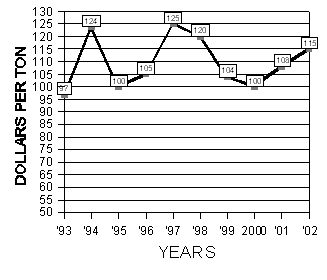Alfalfa Report
Yuma County, Arizona
April 8, 2002
Yuma County Office
2200 W. 28th Street, Ste. 102
Yuma, AZ 85364
(928) 726-3904
(928) 726-8472 FAX
Production Update:
Mechanical conditioning: A major problem with curing hay of any type is that the leaves dry faster than the stems. Mechanical conditioning increases the drying rate for stems. The rubber roller conditioning system is commonly used for alfalfa. A properly adjusted rubber roller should crush the alfalfa stem in two or three spots but not be so vigorous that it tears the stem. Grass hay can be conditioned more vigorously than alfalfa since it is not subject to the same level of leaf loss as alfalfa. Flail conditioners are better suited to grass hay since they are more vigorous than rubber rollers.
Insect Management: Alfalfa insect management depends on good monitoring. Management decisions should be based on accepted standard sampling methods designed to estimate insect pests populations. Choose sampling methods that are reliable for the insect pests being monitored. Check fields once a week and more often when counts show that a pest population is approaching damaging levels. Correct identification of insect pests and their damage is essential. Several factors need to be considered when sampling insect populations. Time of day can greatly influence the reliability of sampling methods. Nocturnal pests hide during the day. Morning dew or strong winds can alter counts of some insects. Sample at several sites in each field quadrant. Avoid field edges for general sampling, but observe field edges for invading insects. Contact your local Cooperative Extension office for information on alfalfa insect pests, sampling procedures, and control measures.
Weed Control: If you had Dodder in your fields last year, you'll
probably have it again this season. Twenty pounds of trifluralin granules
applied now and again in June or July should keep most (85-95%) Dodder
seedlings from becoming established.
| Market Summary |
High
|
Low
|
Average
|
Off grade
|
| Past 2 Weeks (3/26/02 - 4/08/02) |
120
|
105
|
115
|
90-105
|
| Last Year (3/26/01-4/08/02) |
115
|
100
|
108
|
90-110
|
10 Year Summary (March 26, to April 8, 1993-2002):

Issued in furtherance of Cooperative Extension work, acts of May 8 and June 30, 1914, in cooperation with the U.S. Department of Agriculture, James A. Christenson, Director Cooperative Extension, College of Agriculture and Life Sciences, The University of Arizona.
The University of Arizona is an equal opportunity, affirmative action institution. The University does not discriminate on the basis of race, color, religion, sex, national origin, age, disability, veteran status, or sexual orientation in its programs and activities.
Any products, services, or organizations that are
mentioned, shown, or indirectly implied in this web document do not imply
endorsement by The University of Arizona.
Information provided by:
Barry Tickes, btickes@ag.arizona.edu Extension Agent, Yuma County
Michael Ottman, mottman@ag.arizona.edu Agronomy Specialist
College of Agriculture, The University of Arizona.
Eric Natwick, etnatwick@ucdavis.edu UCCE Imperial County - Farm Advisor
University of California, Davis, CA.
Forages: Crop Mgmt | Soil Mgmt | Irrigation | Alfalfa Reports | Insects | Diseases | Weeds | Pesticides
Home | Other Crops | Forages
For more Arizona Production Ag Information:
Home | Cotton | Veggies| Forages | Grains | Citrus | Crop x Crop | Insects | Diseases| Weeds | Pesticides | News | Weather | Research | Photos | Contacts | General Info. | Site Map
Copyright © 2001 University of Arizona,
College of Agriculture and Life Sciences
Webmaster: Al Fournier (fournier@ag.arizona.edu)